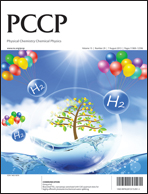The structural and electronic properties of tubular gold clusters with a spinal support
Abstract
Scalar relativistic density functional theory (DFT) is used to investigate the structural and electronic properties of an endohedrally doped hollow tube of gold with a hexagonal cross-section, XMAuN (X = Si, Al and Au, M = 3, 6, 9 and N = 24, 42, 60). Only Si as a dopant can be encapsulated to provide a stable backbone to the parent tubular AuN whereas structures containing an Al or Au backbone are distorted into non-cage like structures as the size increases. The dopant atoms increase the electron density around the Fermi level and shift the d-energy levels to deeper energy levels, thus reducing the HOMO–LUMO gap of the AuN tube. The effect is more pronounced in the Si doped AuN than the Al or Au doped AuN tubes. The Si9Au60 structure, though stable, shows a slight bending which can be corrected by removing one Si atom from the backbone which provides it with the correct amount of space. It can be concluded that Si and Al atoms can form long chains within the Au


 Please wait while we load your content...
Please wait while we load your content...